A Systematic Design Framework for Zero Carbon Campuses: Investigating the Shanghai Jiao Tong University Fahua Campus Case
Abstract
1. Introduction
- What is the role of top-level strategic planning and goals in achieving zero carbon campuses?
- What is the implementation pathway for universities to achieve net zero CO2 emissions?
- How do the various strategies for achieving zero carbon campuses interact in the social, technological, and ecological dimensions?
- How can emerging technologies empower the full lifecycle operation of zero carbon campuses and promote smart governance?
2. Methodology
2.1. Literature Review Method
2.2. Case Study Method
3. Literature Review
3.1. Definition and Carbon Neutrality Strategies for Zero Carbon Campuses
3.2. Zero Carbon Campus Systematic Design Dimensions
3.3. Practical Development of Zero Carbon Campus Systematic Design
4. Case Study
4.1. Theoretical Framework
4.1.1. Components of the Zero Carbon Campus Systematic Design Framework
- One Top-down Vision: Carbon neutrality
- 2.
- Two Complementary Paths: Carbon emission reduction and carbon sink
- 3.
- Three Coupling Dimensions: Social, Technical, and Ecological dimensions
- 4.
- Carbon-neutral Smart Services Platform
4.1.2. The Framework of Zero Carbon Campus Systematic Design
4.2. Application of the Zero Carbon Campus Systematic Design Framework
4.2.1. Planning Background
4.2.2. One Top-Down Vision: Carbon Neutrality
4.2.3. Two Complementary Paths: Carbon Emission Reduction and Carbon Sink
4.2.4. Three Coupling Dimensions: Social, Technical, and Ecological Dimensions
4.2.5. Carbon-Neutral Smart Services Platform
4.3. The Iterative Framework for the Systematic Design of the Zero Carbon Campus
5. Discussion
6. Conclusions
Author Contributions
Funding
Institutional Review Board Statement
Informed Consent Statement
Data Availability Statement
Acknowledgments
Conflicts of Interest
Abbreviations
| CCER | Chinese certified emission reduction |
| GHG | Greenhouse gas |
| CCUS | Carbon capture, usage and storage |
| HEI | Higher education institution |
| EFE | Ecological footprint evaluation |
| LCA | Life cycle assessment |
| EFI | Ecological footprint index |
| CO2 | Carbon dioxide |
| UAV | Unmanned aerial vehicle |
| BIPV | Building integrated photovoltaic |
References
- The Paris Agreement|UNFCCC. Available online: https://unfccc.int/process-and-meetings/the-paris-agreement/the-paris-agreement (accessed on 13 February 2023).
- European Climate Law. Available online: https://climate.ec.europa.eu/eu-action/european-green-deal/european-climate-law_en (accessed on 13 February 2023).
- US EPA. Inventory of U.S. Greenhouse Gas Emissions and Sinks. Available online: https://www.epa.gov/ghgemissions/inventory-us-greenhouse-gas-emissions-and-sinks (accessed on 13 February 2023).
- Jain, S.; Pant, P. Environmental Management Systems for Educational Institutions: A Case Study of TERI University, New Delhi. Int. J. Sustain. High. Educ. 2010, 11, 236–249. [Google Scholar] [CrossRef]
- Shea, R.P.; Worsham, M.O.; Chiasson, A.D.; Kissock, J.K.; McCall, B.J. A Lifecycle Cost Analysis of Transitioning to a Fully-Electrified, Renewably Powered, and Carbon-Neutral Campus at the University of Dayton. Sustain. Energy Technol. Assess. 2020, 37, 100576. [Google Scholar] [CrossRef]
- Klein-Banai, C.; Theis, T.L. Quantitative Analysis of Factors Affecting Greenhouse Gas Emissions at Institutions of Higher Education. J. Clean. Prod. 2013, 48, 29–38. [Google Scholar] [CrossRef]
- Purcell, W.M.; Henriksen, H.; Spengler, J.D. Universities as the Engine of Transformational Sustainability toward Delivering the Sustainable Development Goals: “Living Labs” for Sustainability. Int. J. Sustain. High. Educ. 2019, 20, 1343–1357. [Google Scholar] [CrossRef]
- He, B.-J.; Zhao, D.-X.; Zhu, J.; Darko, A.; Gou, Z.-H. Promoting and Implementing Urban Sustainability in China: An Integration of Sustainable Initiatives at Different Urban Scales. Habitat Int. 2018, 82, 83–93. [Google Scholar] [CrossRef]
- Opel, O.; Strodel, N.; Werner, K.F.; Geffken, J.; Tribel, A.; Ruck, W.K.L. Climate-Neutral and Sustainable Campus Leuphana University of Lueneburg. Energy 2017, 141, 2628–2639. [Google Scholar] [CrossRef]
- Carbon Neutral University—Sustainability. Available online: https://www.csu.edu.au/sustainability/about-us/carbon-neutral-university (accessed on 13 February 2023).
- University of San Francisco Achieves Carbon Neutrality More Than 30 Years Ahead of Goal|University of San Francisco. Available online: https://www.usfca.edu/news/university-san-francisco-achieves-carbon-neutrality-more-30-years-ahead-goal (accessed on 13 February 2023).
- Zheng, N.; Li, S.; Wang, Y.; Huang, Y.; Bartoccid, P.; Fantozzid, F.; Huang, J.; Xing, L.; Yang, H.; Chen, H.; et al. Research on Low-Carbon Campus Based on Ecological Footprint Evaluation and Machine Learning: A Case Study in China. J. Clean. Prod. 2021, 323, 129181. [Google Scholar] [CrossRef]
- Ridhosari, B.; Rahman, A. Carbon Footprint Assessment at Universitas Pertamina from the Scope of Electricity, Transportation, and Waste Generation: Toward a Green Campus and Promotion of Environmental Sustainability. J. Clean. Prod. 2020, 246, 119172. [Google Scholar] [CrossRef]
- Harangozo, G.; Szigeti, C. Corporate Carbon Footprint Analysis in Practice—With a Special Focus on Validity and Reliability Issues. J. Clean. Prod. 2017, 167, 1177–1183. [Google Scholar] [CrossRef]
- Vázquez-Rowe, I.; Villanueva-Rey, P.; Mallo, J.; De la Cerda, J.J.; Moreira, M.T.; Feijoo, G. Carbon Footprint of a Multi-Ingredient Seafood Product from a Business-to-Business Perspective. J. Clean. Prod. 2013, 44, 200–210. [Google Scholar] [CrossRef]
- Mustafa, A.; Kazmi, M.; Khan, H.R.; Qazi, S.A.; Lodi, S.H. Towards a Carbon Neutral and Sustainable Campus: Case Study of NED University of Engineering and Technology. Sustainability 2022, 14, 794. [Google Scholar] [CrossRef]
- Varon-Hoyos, M.; Osorio-Tejada, J.; Morales-Pinzon, T. Carbon Footprint of a University Campus from Colombia. Carbon Manag. 2021, 12, 93–107. [Google Scholar] [CrossRef]
- Tian, X.; Zhou, Y.; Morris, B.; You, F. Sustainable Design of Cornell University Campus Energy Systems toward Climate Neutrality and 100% Renewables. Renew. Sustain. Energy Rev. 2022, 161, 112383. [Google Scholar] [CrossRef]
- Olivieri, L.; Caamano-Martin, E.; Sassenou, L.-N.; Olivieri, F. Contribution of Photovoltaic Distributed Generation to the Transition towards an Emission-Free Supply to University Campus: Technical, Economic Feasibility and Carbon Emission Reduction at the Universidad Politecnica de Madrid. Renew. Energy 2020, 162, 1703–1714. [Google Scholar] [CrossRef]
- Li, X.; Tan, H.; Rackes, A. Carbon Footprint Analysis of Student Behavior for a Sustainable University Campus in China. J. Clean. Prod. 2015, 106, 97–108. [Google Scholar] [CrossRef]
- Liu, H.; Wang, X.; Yang, J.; Zhou, X.; Liu, Y. The Ecological Footprint Evaluation of Low Carbon Campuses Based on Life Cycle Assessment: A Case Study of Tianjin, China. J. Clean. Prod. 2017, 144, 266–278. [Google Scholar] [CrossRef]
- Idundun, E.; Hursthouse, A.; McLellan, I. Carbon Management in UK Higher Education Institutions: An Overview. Sustainability 2021, 13, 10896. [Google Scholar] [CrossRef]
- Amaral, L.; Martins, N.; Gouveia, J. Quest for a Sustainable University: A Review. Int. J. Sustain. High. Educ. 2015, 16, 155–172. [Google Scholar] [CrossRef]
- Amaral, A.R.; Rodrigues, E.; Gaspar, A.R.; Gomes, A. A Review of Empirical Data of Sustainability Initiatives in University Campus Operations. J. Clean. Prod. 2020, 250, 119558. [Google Scholar] [CrossRef]
- Mastos, T.; Gotzamani, K. Sustainable Supply Chain Management in the Food Industry: A Conceptual Model from a Literature Review and a Case Study. Foods 2022, 11, 2295. [Google Scholar] [CrossRef]
- Ozarisoy, B.; Altan, H. Limitations: Developing an Evidence-Based Energy Policy Framework to Asset Robust Energy Performance Evaluation and Certification Schemes. In Handbook of Retrofitting High Density Residential Buildings; Springer International Publishing: Cham, Switzerland, 2022; pp. 617–640. ISBN 978-3-031-11853-1. [Google Scholar]
- Ozarisoy, B. Energy Effectiveness of Passive Cooling Design Strategies to Reduce the Impact of Long-Term Heatwaves on Occupants’ Thermal Comfort in Europe: Climate Change and Mitigation. J. Clean. Prod. 2022, 330, 129675. [Google Scholar] [CrossRef]
- Appleyard, B.; Frost, A.R.; Cordova, E.; McKinstry, J. Pathways Toward Zero-Carbon Campus Commuting: Innovative Approaches in Measuring, Understanding, and Reducing Greenhouse Gas Emissions. Transp. Res. Rec. 2018, 2672, 87–97. [Google Scholar] [CrossRef]
- Helmers, E.; Chang, C.C.; Dauwels, J. Carbon Footprinting of Universities Worldwide Part II: First Quantification of Complete Embodied Impacts of Two Campuses in Germany and Singapore. Sustainability 2022, 14, 3865. [Google Scholar] [CrossRef]
- Mendoza-Flores, R.; Quintero-Ramirez, R.; Ortiz, I. The Carbon Footprint of a Public University Campus in Mexico City. Carbon Manag. 2019, 10, 501–511. [Google Scholar] [CrossRef]
- Cano, N.; Berrio, L.; Carvajal, E.; Arango, S. Assessing the Carbon Footprint of a Colombian University Campus Using the UNE-ISO 14064-1 and WRI/WBCSD GHG Protocol Corporate Standard. Environ. Sci. Pollut. Res. 2023, 30, 3980–3996. [Google Scholar] [CrossRef]
- Feng, J.-C.; Yan, J.; Yu, Z.; Zeng, X.; Xu, W. Case Study of an Industrial Park toward Zero Carbon Emission. Appl. Energy 2018, 209, 65–78. [Google Scholar] [CrossRef]
- Bumbiere, K.; Barisa, A.; Pubule, J.; Blumberga, D.; Gomez-Navarro, T. Transition to Climate Neutrality at University Campus. Case Study in Europe, Riga. Environ. Clim. Technol. 2022, 26, 941–954. [Google Scholar] [CrossRef]
- Gulcin, D.; van den Bosch, C.C.K. Assessment of Above-Ground Carbon Storage by Urban Trees Using LiDAR Data: The Case of a University Campus. Forests 2021, 12, 62. [Google Scholar] [CrossRef]
- Fox, W.; Dwivedi, P.; Lowe, R.C., III; Welch, S.; Fuller, M. Estimating Carbon Stock of Live Trees Located on the Main Campus of the University of Georgia. J. For. 2020, 118, 457–465. [Google Scholar] [CrossRef]
- Park, S.-I.; Um, J.-S. Differentiating Carbon Sinks versus Sources on a University Campus Using Synergistic UAV NIR and Visible Signatures. Environ. Monit. Assess. 2018, 190, 652. [Google Scholar] [CrossRef]
- Tonietto, R.; O’Brien, L.; Van Haitsma, C.; Su, C.; Blankertz, N.; Mosiniak, H.G.S.; Short, C.; Dawson, H.A. Toward a Carbon Neutral Campus: A Scalable Approach to Estimate Carbon Storage and Biosequestration, an Example from University of Michigan. Int. J. Sustain. High. Educ. 2021, 22, 1108–1124. [Google Scholar] [CrossRef]
- Cox, H.M. A Sustainability Initiative to Quantify Carbon Sequestration by Campus Trees. J. Geogr. 2012, 111, 173–183. [Google Scholar] [CrossRef]
- Robinson, O.J.; Tewkesbury, A.; Kemp, S.; Williams, I.D. Towards a Universal Carbon Footprint Standard: A Case Study of Carbon Management at Universities. J. Clean. Prod. 2018, 172, 4435–4455. [Google Scholar] [CrossRef]
- Li, R.; Zhao, R.; Xie, Z.; Xiao, L.; Chuai, X.; Feng, M.; Zhang, H.; Luo, H. Water-Energy-Carbon Nexus at Campus Scale: Case of North China University of Water Resources and Electric Power. Energy Policy 2022, 166, 113001. [Google Scholar] [CrossRef]
- Emeakaroha, A.; Ang, C.S.; Yan, Y.; Hopthrow, T. Integrating Persuasive Technology with Energy Delegates for Energy Conservation and Carbon Emission Reduction in a University Campus. Energy 2014, 76, 357–374. [Google Scholar] [CrossRef]
- Ho, Y.-F.; Chang, C.-C.; Wei, C.-C.; Wang, H.-L. Multi-Objective Programming Model for Energy Conservation and Renewable Energy Structure of a Low Carbon Campus. Energy Build. 2014, 80, 461–468. [Google Scholar] [CrossRef]
- Kerem, A. Assessing the Electricity Energy Efficiency of University Campus Exterior Lighting System and Proposing Energy-Saving Strategies for Carbon Emission Reduction. Microsyst. Technol.-Micro-Nanosyst.-Inf. Storage Process. Syst. 2022, 28, 2623–2640. [Google Scholar] [CrossRef]
- Del Borghi, A.; Spiegelhalter, T.; Moreschi, L.; Gallo, M. Carbon-Neutral-Campus Building: Design Versus Retrofitting of Two University Zero Energy Buildings in Europe and in the United States. Sustainability 2021, 13, 9023. [Google Scholar] [CrossRef]
- Legorburu, G.; Smith, A.D. Incorporating Observed Data into Early Design Energy Models for Life Cycle Cost and Carbon Emissions Analysis of Campus Buildings. Energy Build. 2020, 224, 110279. [Google Scholar] [CrossRef]
- Emeakaroha, A.; Ang, C.S.; Yan, Y.; Hopthrow, T. A Persuasive Feedback Support System for Energy Conservation and Carbon Emission Reduction in Campus Residential Buildings. Energy Build. 2014, 82, 719–732. [Google Scholar] [CrossRef]
- Kourgiozou, V.; Commin, A.; Dowson, M.; Rovas, D.; Mumovic, D. Scalable Pathways to Net Zero Carbon in the UK Higher Education Sector: A Systematic Review of Smart Energy Systems in University Campuses. Renew. Sustain. Energy Rev. 2021, 147, 111234. [Google Scholar] [CrossRef]
- Wang, S.; Wang, H.; Xie, P.; Chen, X. Life-Cycle Assessment of Carbon Footprint of Bike-Share and Bus Systems in Campus Transit. Sustainability 2021, 13, 158. [Google Scholar] [CrossRef]
- Zimmermann, S.; Baeumer, T.; Mueller, P. Achieving a Climate-Neutral Campus: A Psychological Analysis of the Participation Process with the Stage Model of Participation. In Handbook of Sustainability and Social Science Research; Filho, W.L., Marans, R.W., Callewaert, J., Eds.; Springer International Publishing Ag: Cham, Switzerland, 2018; pp. 227–243. ISBN 978-3-319-67122-2. [Google Scholar]
- Jain, S.; Agarwal, A.; Jani, V.; Singhal, S.; Sharma, P.; Jalan, R. Assessment of Carbon Neutrality and Sustainability in Educational Campuses (CaNSEC): A General Framework. Ecol. Indic. 2017, 76, 131–143. [Google Scholar] [CrossRef]
- Cao, X.; Dai, X.; Liu, J. Building Energy-Consumption Status Worldwide and the State-of-the-Art Technologies for Zero-Energy Buildings during the Past Decade. Energy Build. 2016, 128, 198–213. [Google Scholar] [CrossRef]
- Pouttu, A.; Haapola, J.; Ahokangas, P.; Xu, Y.; Kopsakangas-Savolainen, M.; Porras, E.; Matamoros, J.; Kalalas, C.; Alonso-Zarate, J.; Gallego, F.D.; et al. P2P Model for Distributed Energy Trading, Grid Control and ICT for Local Smart Grids. In Proceedings of the 2017 European Conference on Networks and Communications (EuCNC), Oulu, Finland, 12–15 June 2017; pp. 1–6. [Google Scholar]
- Wang, N.; Xu, W.; Xu, Z.; Shao, W. Peer-to-Peer Energy Trading among Microgrids with Multidimensional Willingness. Energies 2018, 11, 3312. [Google Scholar] [CrossRef]
- Hahn, R.; Kühnen, M. Determinants of Sustainability Reporting: A Review of Results, Trends, Theory, and Opportunities in an Expanding Field of Research. J. Clean. Prod. 2013, 59, 5–21. [Google Scholar] [CrossRef]
- Dawe, G.; Jucker, R.; Martin, S. Sustainable Development in Higher Education: Current Practice and Future Developments. Available online: https://www.researchgate.net/publication/228387553_Sustainable_Development_in_Higher_Education_Current_Practice_and_Future_Developments (accessed on 9 May 2023).
- Shriberg, M. Institutional Assessment Tools for Sustainability in Higher Education: Strengths, Weaknesses, and Implications for Practice and Theory. High. Educ. Policy 2002, 15, 153–167. [Google Scholar] [CrossRef]
- Alshuwaikhat, H.M.; Abubakar, I. An Integrated Approach to Achieving Campus Sustainability: Assessment of the Current Campus Environmental Management Practices. J. Clean. Prod. 2008, 16, 1777–1785. [Google Scholar] [CrossRef]
- Coccoli, M.; Guercio, A.; Maresca, P.; Stanganelli, L. Smarter Universities: A Vision for the Fast Changing Digital Era. J. Vis. Lang. Comput. 2014, 25, 1003–1011. [Google Scholar] [CrossRef]
- Moreno, M.V.; Dufour, L.; Skarmeta, A.F.; Jara, A.J.; Genoud, D.; Ladevie, B.; Bezian, J.-J. Big Data: The Key to Energy Efficiency in Smart Buildings. Soft Comput. 2016, 20, 1749–1762. [Google Scholar] [CrossRef]
- Shi, H.; Lai, E. An Alternative University Sustainability Rating Framework with a Structured Criteria Tree. J. Clean. Prod. 2013, 61, 59–69. [Google Scholar] [CrossRef]
- Muhamad, W.; Kurniawan, N.B.; Suhardi; Yazid, S. Smart Campus Features, Technologies, and Applications: A Systematic Literature Review. In Proceedings of the 2017 International Conference on Information Technology Systems and Innovation (ICITSI), Bandung, Indonesia, 23–24 October 2017; pp. 384–391. [Google Scholar]
- Mitchell Finnigan, S.; Clear, A.K.; Olivier, P. SpaceBot: Towards Participatory Evaluation of Smart Buildings. In Proceedings of the Extended Abstracts of the 2018 CHI Conference on Human Factors in Computing Systems, Montreal, QC, Canada, 21–26 April 2018; Association for Computing Machinery: New York, NY, USA, 2018; pp. 1–6. [Google Scholar]
- Hawkins, D.; Hong, S.M.; Raslan, R.; Mumovic, D.; Hanna, S. Determinants of Energy Use in UK Higher Education Buildings Using Statistical and Artificial Neural Network Methods. Int. J. Sustain. Built Environ. 2012, 1, 50–63. [Google Scholar] [CrossRef]
- Velazquez, L.; Munguia, N.; Platt, A.; Taddei, J. Sustainable University: What Can Be the Matter? J. Clean. Prod. 2006, 14, 810–819. [Google Scholar] [CrossRef]
- Lozano, R. The State of Sustainability Reporting in Universities. Int. J. Sustain. High. Educ. 2011, 12, 67–78. [Google Scholar] [CrossRef]
- Vasileva, R.; Rodrigues, L.; Hughes, N.; Greenhalgh, C.; Goulden, M.; Tennison, J. What Smart Campuses Can Teach Us about Smart Cities: User Experiences and Open Data. Information 2018, 9, 251. [Google Scholar] [CrossRef]
- Gu, Y.; Wang, H.; Xu, J.; Wang, Y.; Wang, X.; Robinson, Z.P.; Li, F.; Wu, J.; Tan, J.; Zhi, X. Quantification of Interlinked Environmental Footprints on a Sustainable University Campus: A Nexus Analysis Perspective. Appl. Energy 2019, 246, 65–76. [Google Scholar] [CrossRef]
- Xu, Y.; Yan, C.; Liu, H.; Wang, J.; Yang, Z.; Jiang, Y. Smart Energy Systems: A Critical Review on Design and Operation Optimization. Sustain. Cities Soc. 2020, 62, 102369. [Google Scholar] [CrossRef]
- Shaffer, B.; Flores, R.; Samuelsen, S.; Anderson, M.; Mizzi, R.; Kuitunen, E. Urban Energy Systems and the Transition to Zero Carbon—Research and Case Studies from the USA and Europe. Energy Procedia 2018, 149, 25–38. [Google Scholar] [CrossRef]
- Phuangpornpitak, N.; Tia, S. Opportunities and Challenges of Integrating Renewable Energy in Smart Grid System. Energy Procedia 2013, 34, 282–290. [Google Scholar] [CrossRef]
- Biresselioglu, M.E.; Nilsen, M.; Demir, M.H.; Røyrvik, J.; Koksvik, G. Examining the Barriers and Motivators Affecting European Decision-Makers in the Development of Smart and Green Energy Technologies. J. Clean. Prod. 2018, 198, 417–429. [Google Scholar] [CrossRef]
- Andersson, E.; Langemeyer, J.; Borgström, S.; McPhearson, T.; Haase, D.; Kronenberg, J.; Barton, D.N.; Davis, M.; Naumann, S.; Röschel, L.; et al. Enabling Green and Blue Infrastructure to Improve Contributions to Human Well-Being and Equity in Urban Systems. BioScience 2019, 69, 566–574. [Google Scholar] [CrossRef] [PubMed]
- Raymond, C.M.; Frantzeskaki, N.; Kabisch, N.; Berry, P.; Breil, M.; Nita, M.R.; Geneletti, D.; Calfapietra, C. A Framework for Assessing and Implementing the Co-Benefits of Nature-Based Solutions in Urban Areas. Environ. Sci. Policy 2017, 77, 15–24. [Google Scholar] [CrossRef]
- Grabowski, Z.J.; Matsler, A.M.; Thiel, C.; McPhillips, L.; Hum, R.; Bradshaw, A.; Miller, T.; Redman, C. Infrastructures as Socio-Eco-Technical Systems: Five Considerations for Interdisciplinary Dialogue. J. Infrastruct. Syst. 2017, 23, 02517002. [Google Scholar] [CrossRef]
- Depietri, Y.; McPhearson, T. Integrating the Grey, Green, and Blue in Cities: Nature-Based Solutions for Climate Change Adaptation and Risk Reduction. In Nature-Based Solutions to Climate Change Adaptation in Urban Areas: Linkages between Science, Policy and Practice; Kabisch, N., Korn, H., Stadler, J., Bonn, A., Eds.; Theory and Practice of Urban Sustainability Transitions; Springer International Publishing: Cham, Switzerland, 2017; pp. 91–109. ISBN 978-3-319-56091-5. [Google Scholar]
- Ahlborg, H.; Ruiz-Mercado, I.; Molander, S.; Masera, O. Bringing Technology into Social-Ecological Systems Research—Motivations for a Socio-Technical-Ecological Systems Approach. Sustainability 2019, 11, 2009. [Google Scholar] [CrossRef]
- Markolf, S.A.; Chester, M.V.; Eisenberg, D.A.; Iwaniec, D.M.; Davidson, C.I.; Zimmerman, R.; Miller, T.R.; Ruddell, B.L.; Chang, H. Interdependent Infrastructure as Linked Social, Ecological, and Technological Systems (SETSs) to Address Lock-in and Enhance Resilience. Earth’s Future 2018, 6, 1638–1659. [Google Scholar] [CrossRef]
- Andersson, E.; Borgström, S.; Haase, D.; Lanemeyer, J.; Mascarenhas, A.; McPhearson, T.; Wolff, M.; Laszkiewicz, E.; Kronenberg, J.; Barton, D.; et al. A Context-Sensitive Systems Approach for Understanding and Enabling Ecosystem Service Realization in Cities. Ecol. Soc. 2021, 26, 35. [Google Scholar] [CrossRef]
- Grimm, N.B.; Cook, E.M.; Hale, R.L.; Iwaniec, D.M. A Broader Framing of Ecosystem Services in Cities: Benefits and Challenges of Built, Natural or Hybrid System Function. In The Routledge Handbook of Urbanization and Global Environmental Change; Routledge: London, UK, 2015; ISBN 978-1-315-84925-6. [Google Scholar]
- Manuel-Navarrete, D. Double Coupling: Modeling Subjectivity and Asymmetric Organization in Social-Ecological Systems. Ecol. Soc. 2015, 20, 26. [Google Scholar] [CrossRef]
- van Dijk, J.A.G.M. Digital Divide Research, Achievements and Shortcomings. Poetics 2006, 34, 221–235. [Google Scholar] [CrossRef]
- Singh, R.K.; Murty, H.R.; Gupta, S.K.; Dikshit, A.K. An Overview of Sustainability Assessment Methodologies. Ecol. Indic. 2009, 9, 189–212. [Google Scholar] [CrossRef]
- Wang, Z.; Gao, Y.; Wang, X.; Lin, Q.; Li, L. A New Approach to Land Use Optimization and Simulation Considering Urban Development Sustainability: A Case Study of Bortala, China. Sustain. Cities Soc. 2022, 87, 104135. [Google Scholar] [CrossRef]
- Yang, H.; Li, X.; Elliott, M. Integrated Quantitative Evaluation Framework of Sustainable Development—The Complex Case of the Yangtze River Delta. Ocean Coast. Manag. 2023, 232, 106426. [Google Scholar] [CrossRef]
- Zhao, N.; You, F. Can Renewable Generation, Energy Storage and Energy Efficient Technologies Enable Carbon Neutral Energy Transition? Appl. Energy 2020, 279, 115889. [Google Scholar] [CrossRef]
- Lozano, R. Diffusion of Sustainable Development in Universities’ Curricula: An Empirical Example from Cardiff University. J. Clean. Prod. 2010, 18, 637–644. [Google Scholar] [CrossRef]
- Lauder, A.; Sari, R.F.; Suwartha, N.; Tjahjono, G. Critical Review of a Global Campus Sustainability Ranking: GreenMetric. J. Clean. Prod. 2015, 108, 852–863. [Google Scholar] [CrossRef]
- Yuan, X.; Zuo, J.; Huisingh, D. Green Universities in China—What Matters? J. Clean. Prod. 2013, 61, 36–45. [Google Scholar] [CrossRef]
- Guerrieri, M.; La Gennusa, M.; Peri, G.; Rizzo, G.; Scaccianoce, G. University Campuses as Small-Scale Models of Cities: Quantitative Assessment of a Low Carbon Transition Path. Renew. Sustain. Energy Rev. 2019, 113, 109263. [Google Scholar] [CrossRef]
- Di Dio, S.; Massa, F.; Nucara, A.; Peri, G.; Rizzo, G.; Schillaci, D. Pursuing Softer Urban Mobility Behaviors through Game-Based Apps. Heliyon 2020, 6, e03930. [Google Scholar] [CrossRef]
- Marvuglia, A.; Havinga, L.; Heidrich, O.; Fonseca, J.; Gaitani, N.; Reckien, D. Advances and Challenges in Assessing Urban Sustainability: An Advanced Bibliometric Review. Renew. Sustain. Energy Rev. 2020, 124, 109788. [Google Scholar] [CrossRef]
- Fahlstedt, O.; Temeljotov-Salaj, A.; Lohne, J.; Bohne, R.A. Holistic Assessment of Carbon Abatement Strategies in Building Refurbishment Literature—A Scoping Review. Renew. Sustain. Energy Rev. 2022, 167, 112636. [Google Scholar] [CrossRef]
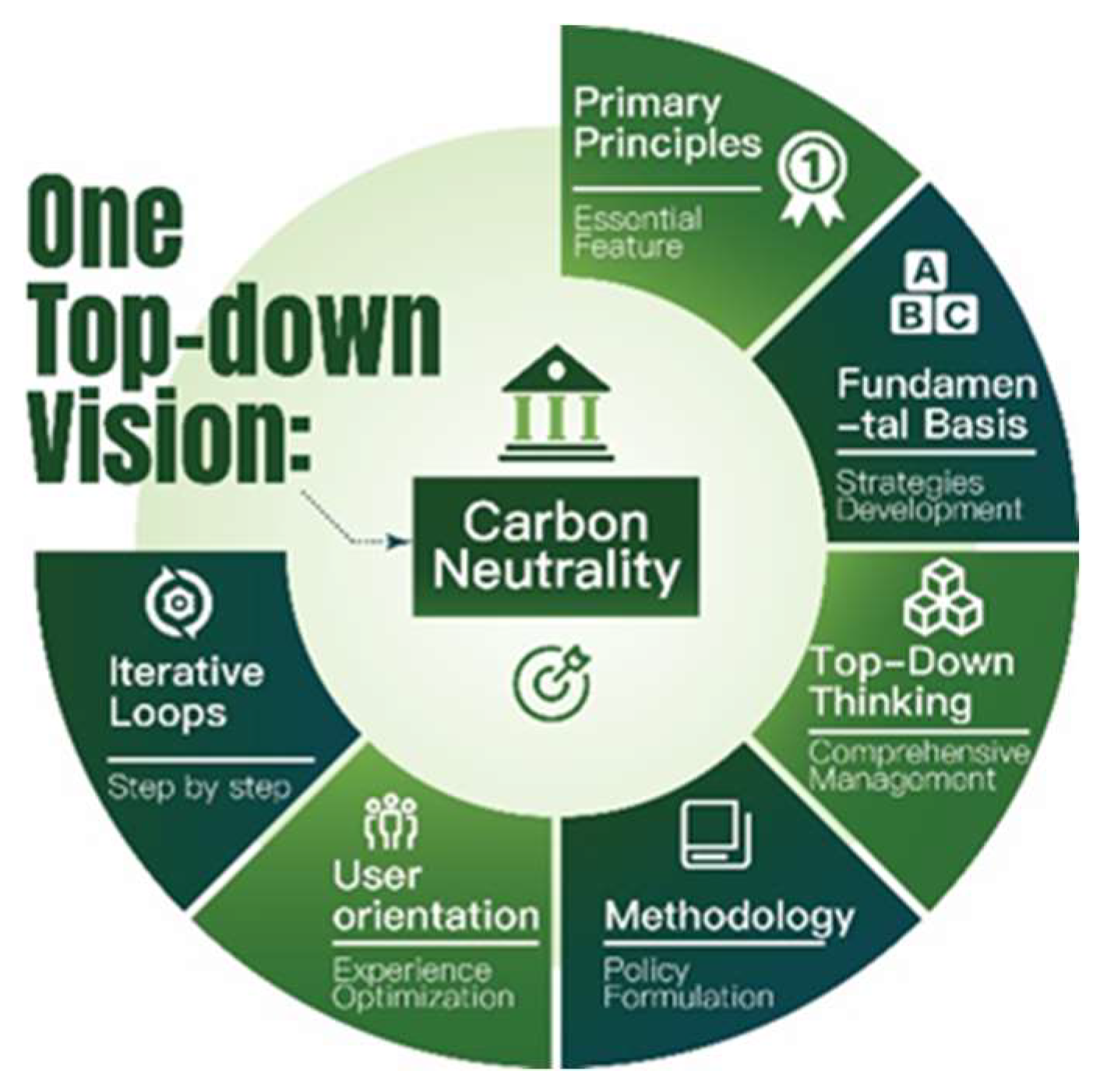
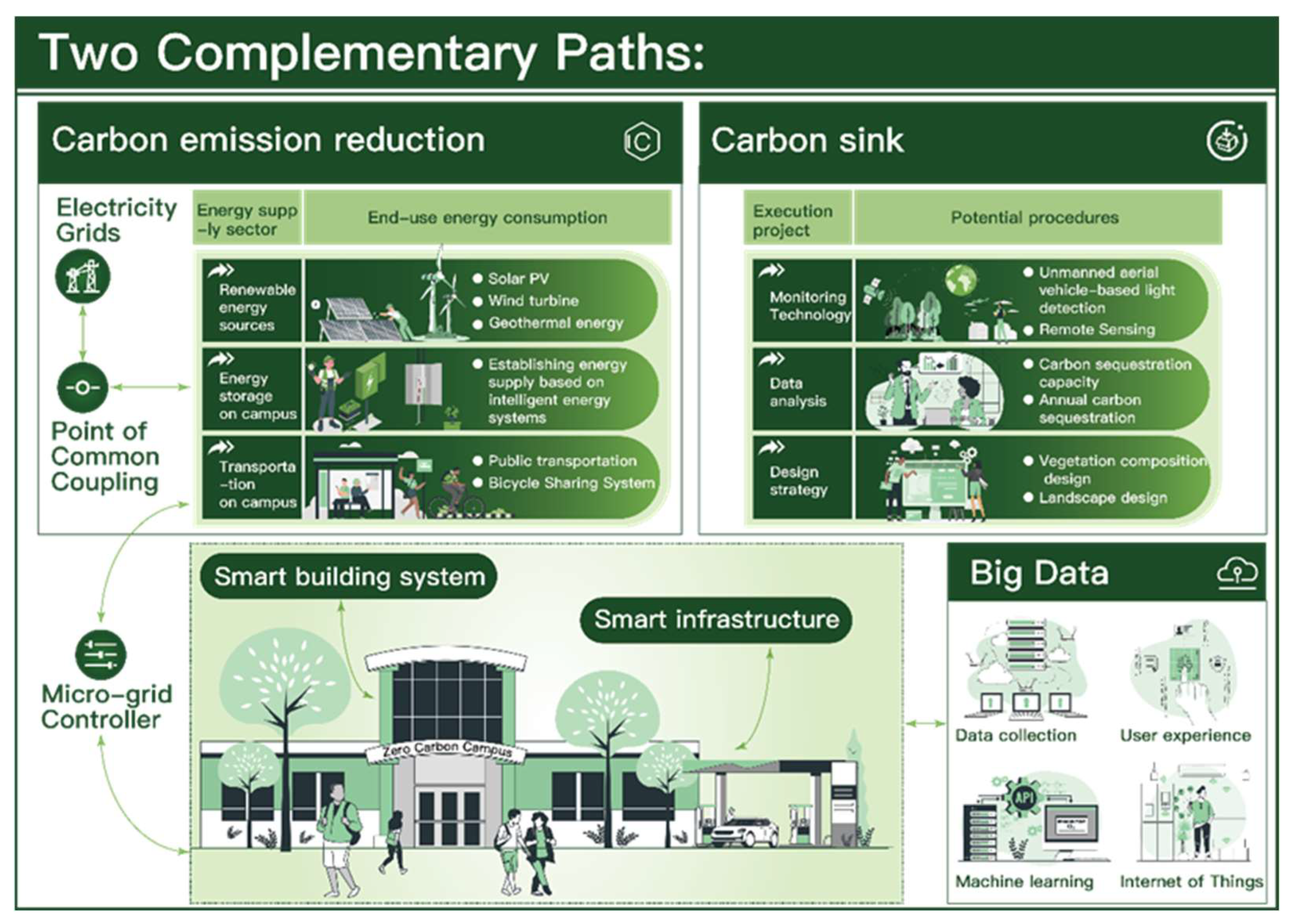
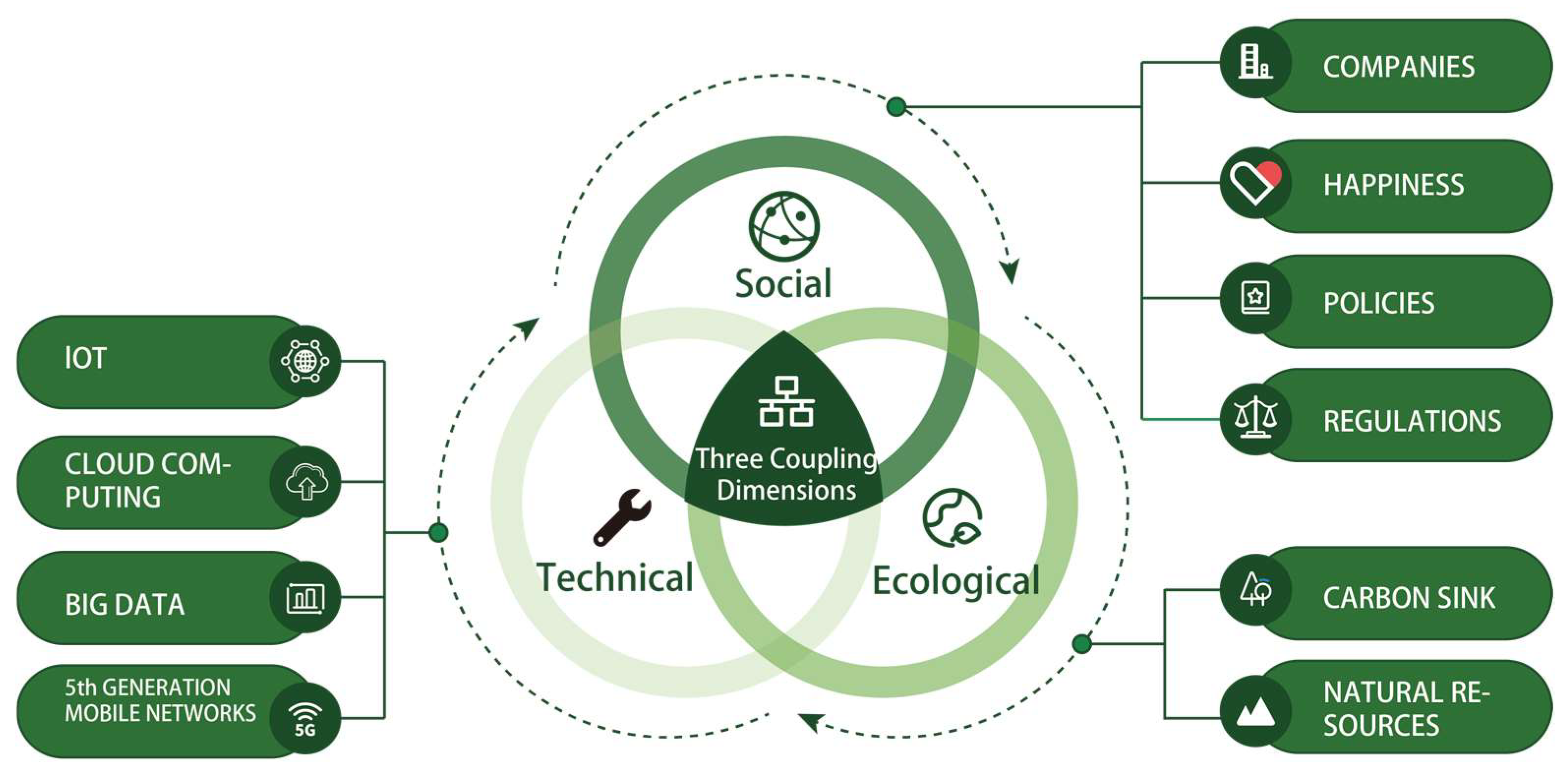

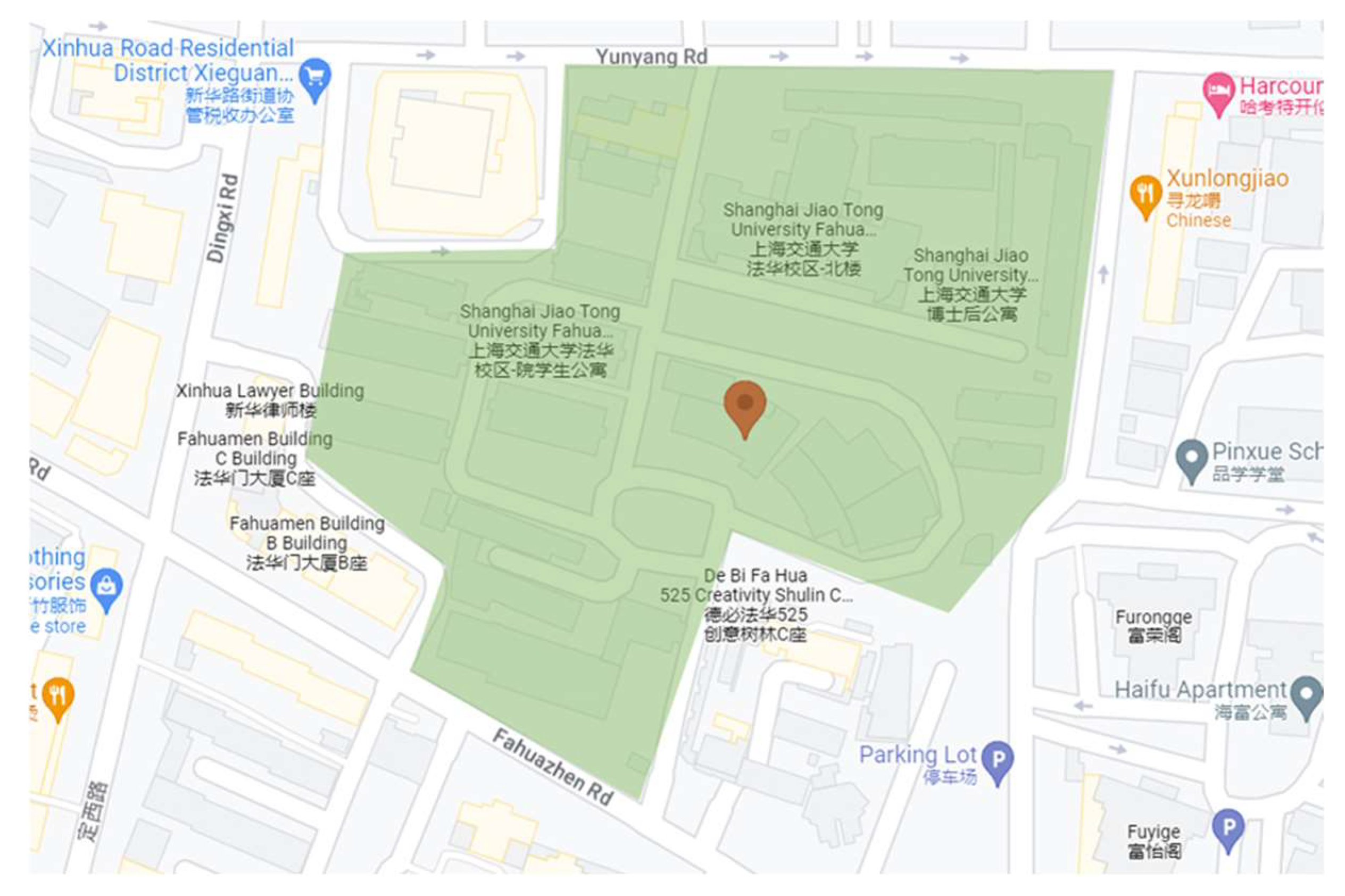
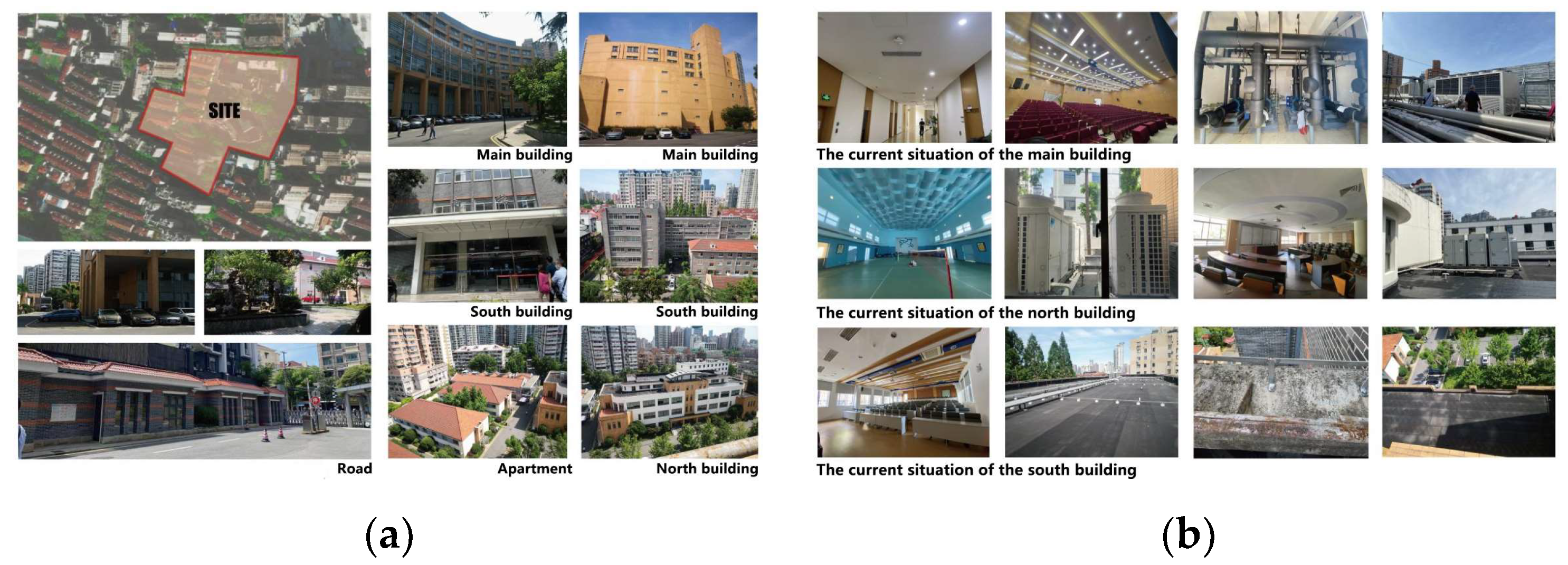

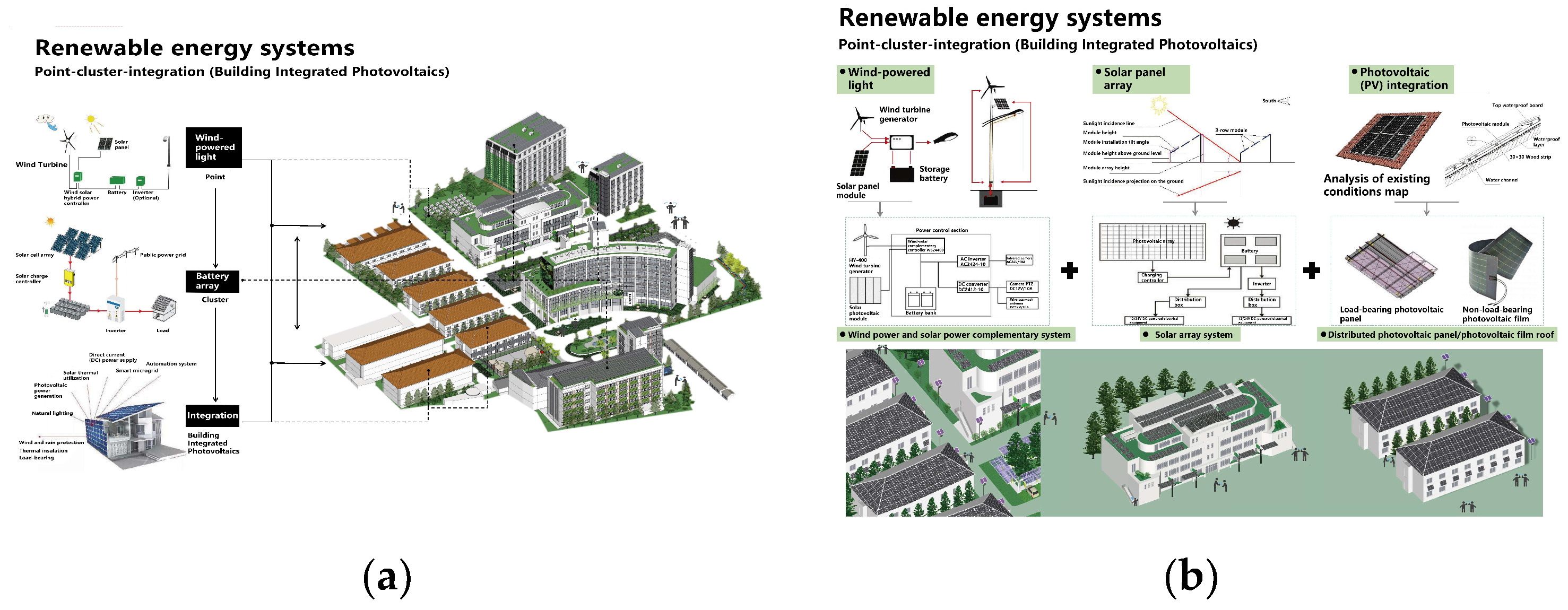
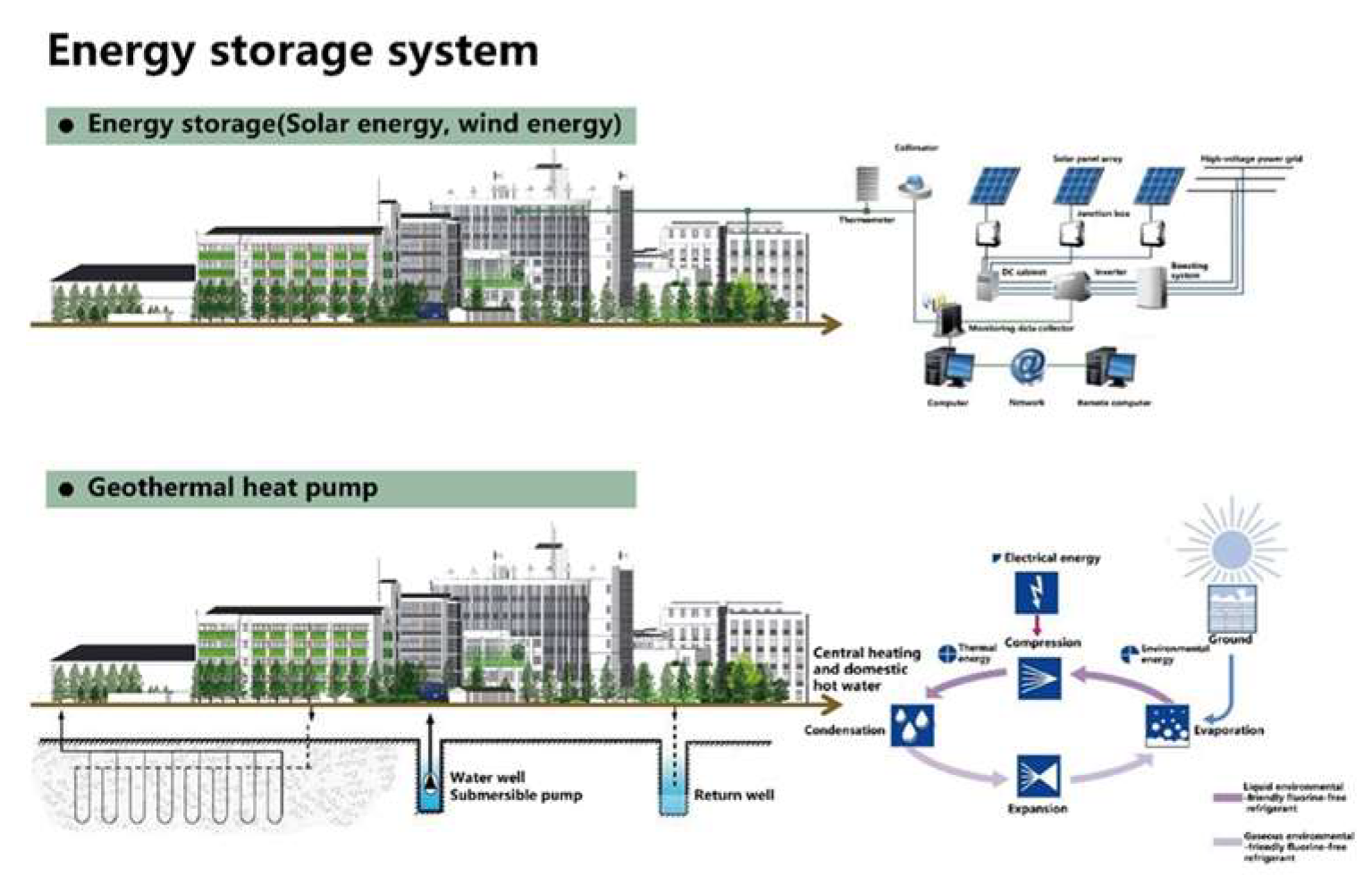
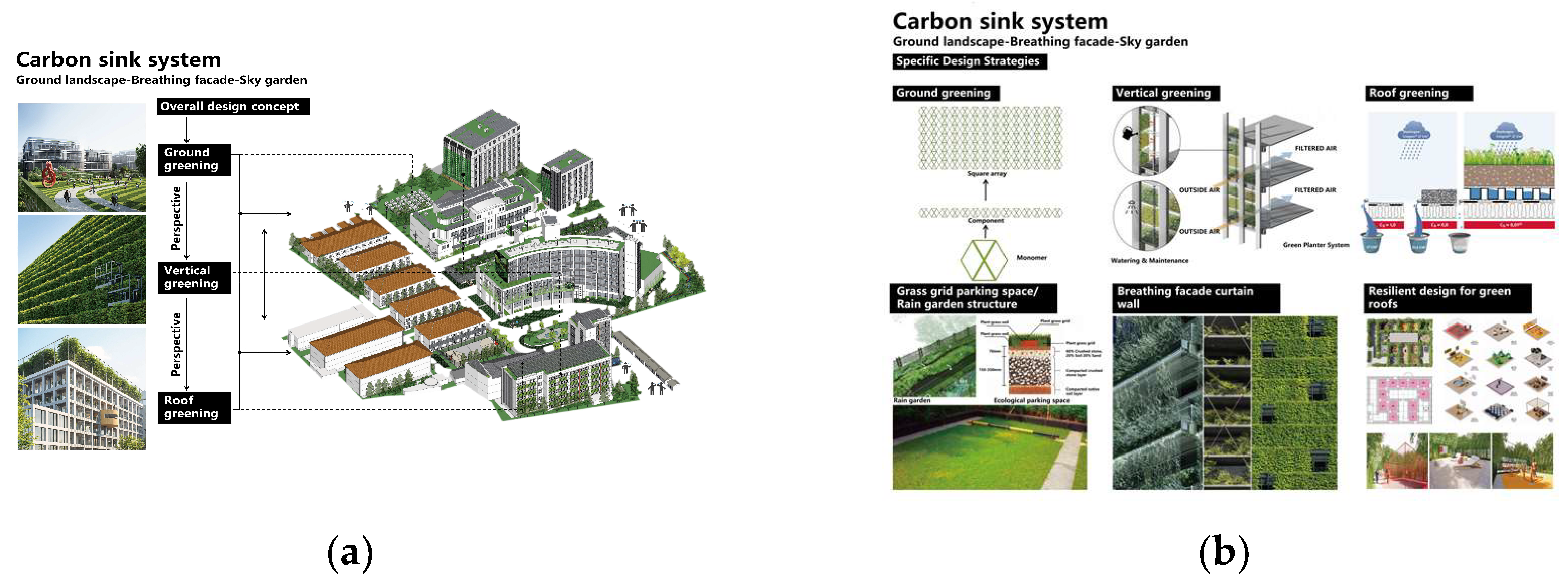
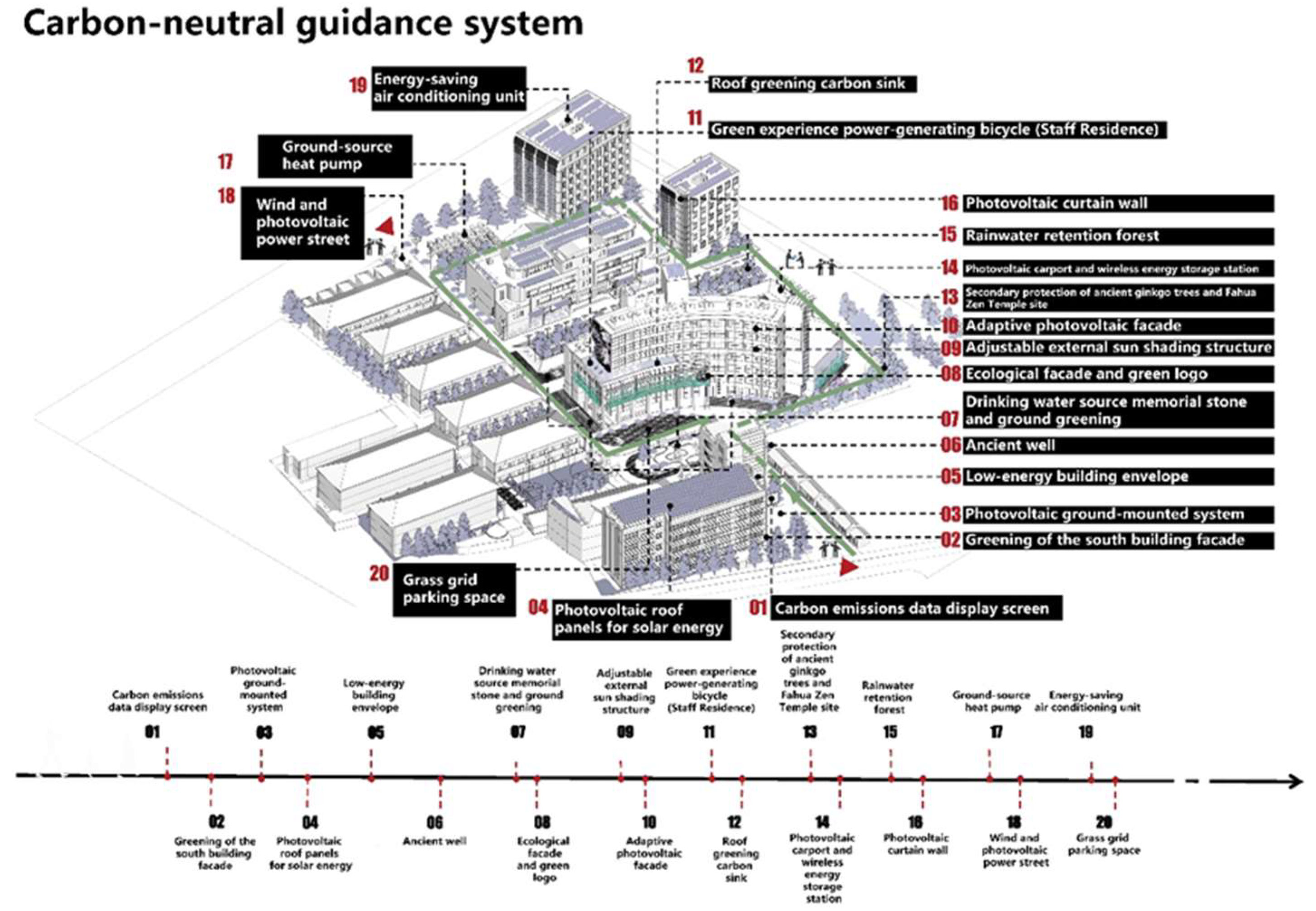
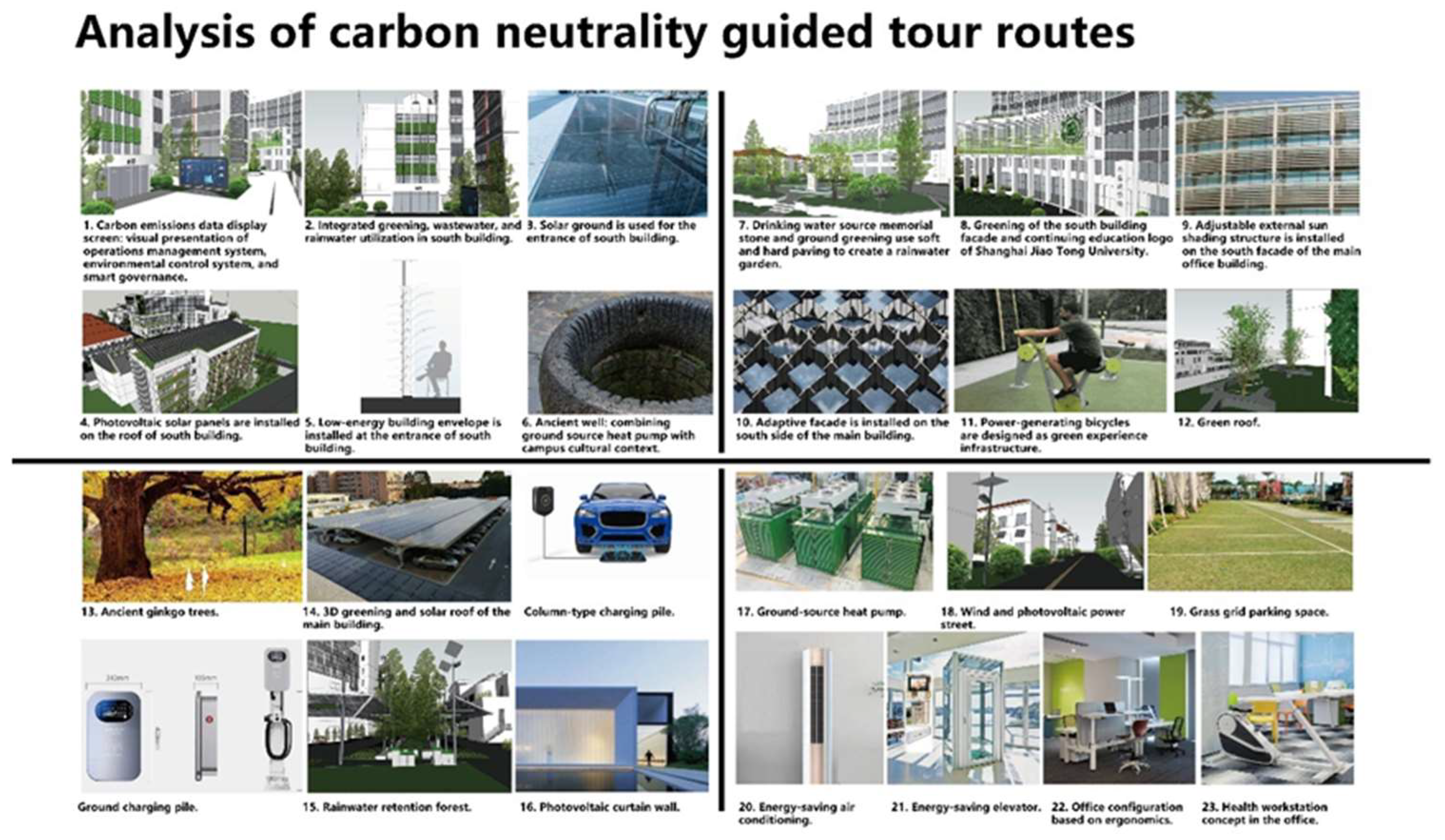
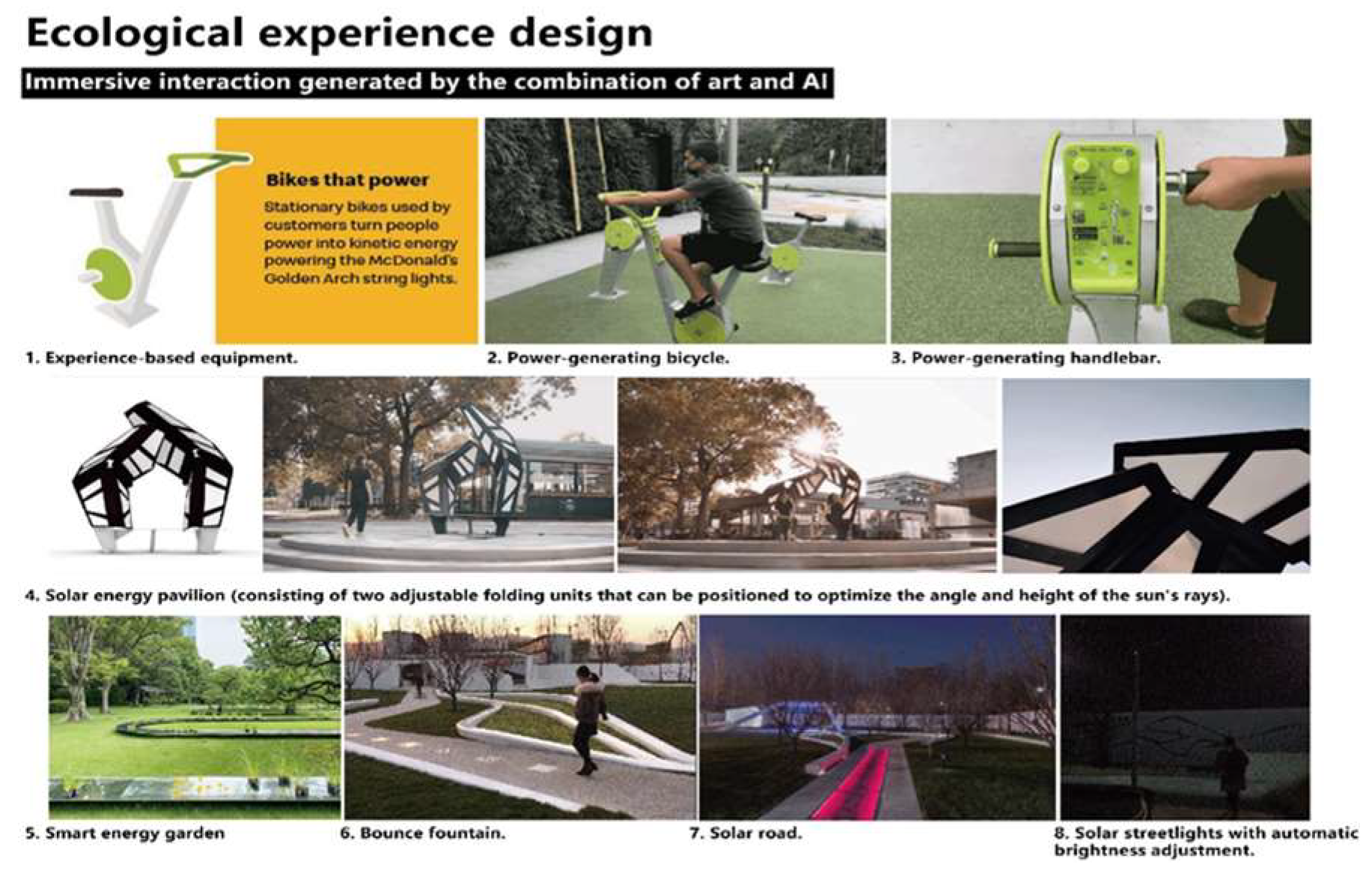

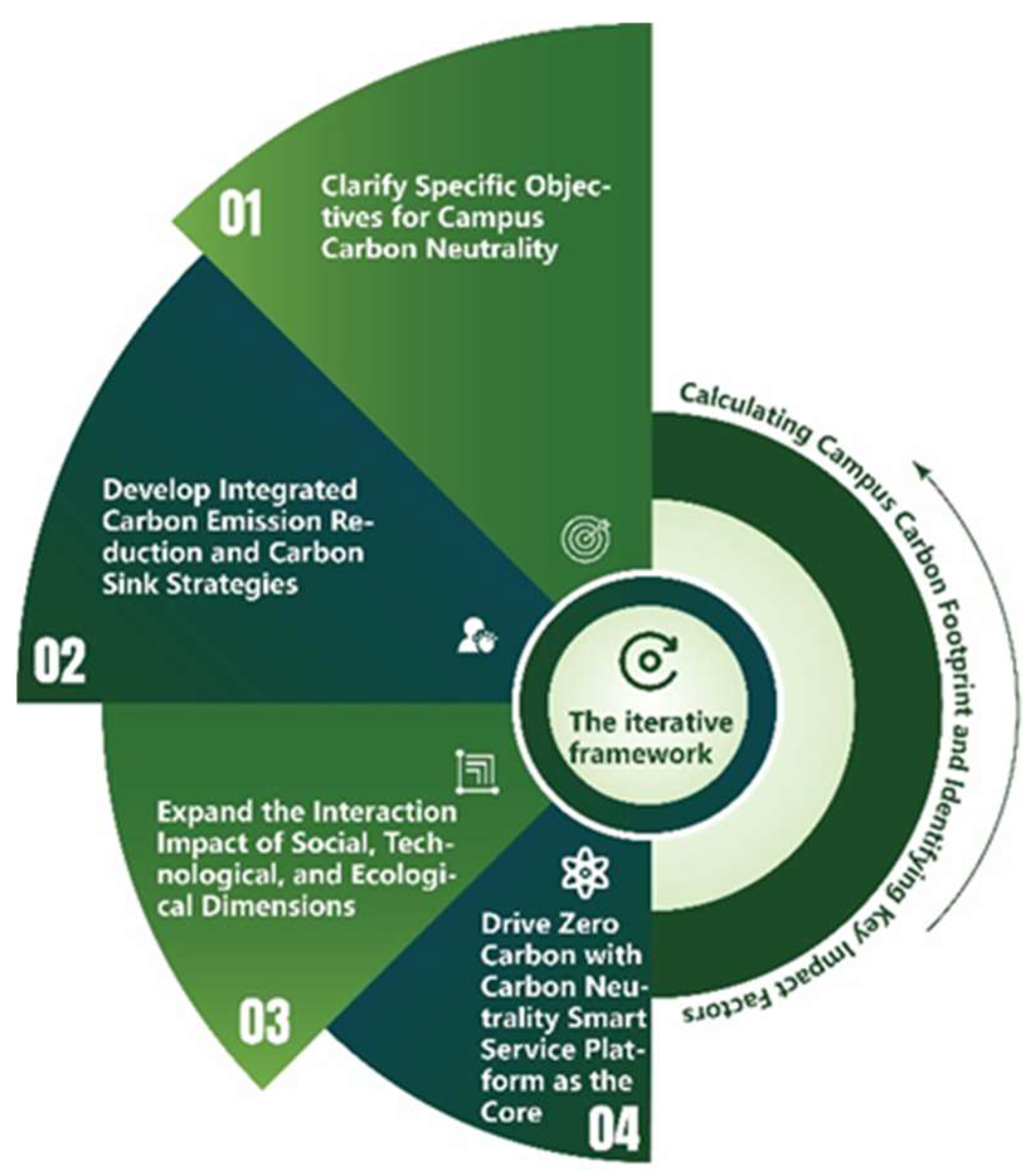
| Research Topics | Research Sub-Topics | List of Literature | Status of Research |
|---|---|---|---|
| Carbon neutrality strategies for zero carbon campuses | From the aspect of carbon emission reduction: The establishment of campus carbon inventories. | Rubén Mendoza-Flores et al. [30] Ketija Bumbiere et al. [33] Natalia Cano et al. [31] Eckard Helmers et al. [29] Pablo Yañez et al. [33] | Electricity consumption and transportation within university campuses are the primary sources of carbon emissions in campus carbon inventories. Therefore, transitioning to renewable energy sources and promoting electric mobility are identified as the primary options for mitigating campus carbon emissions. |
| From the aspect of carbon sink: Monitoring and quantifying campus carbon sinks. | Gulcin, D. and van den Bosch C.C.K. [34] William Fox et al. [35] Seong-Il Park and Jung-Sup Um [36] Rebecca Tonietto et al. [37] Helen M. Cox [38] | HEIs worldwide have taken a proactive approach to researching strategies to reduce their campuses’ overall carbon footprint, and there is increasing interest in the role of carbon sinks in the process of achieving a zero carbon campus. |
| Research Topics | Research Sub-Topics | List of Literature | Status of Research |
|---|---|---|---|
| Zero Carbon Campus Systematic Design Dimensions | From the aspect of comprehensive campus energy planning. | Ruishi Li et al. [40] Anthony Emeakaroha et al. [41] Yu-Feng Ho et al. [42] Alper Kerem [43] | Current campus energy planning investigations can be classified into two categories: developing energy efficiency strategies for existing infrastructure and transitioning to renewable energy. |
| From the aspect of campus building transformation. | Adriana Del Borghi et al. [44] Gabriel Legorburu and Amanda D. Smith [45] Anthony Emeakaroha et al. [46] Vasiliki Kourgiozou et al. [47] | In the higher education sector, campus buildings are a significant source of GHG emissions, driven by expanding infrastructure and activities. The functional grouping of buildings and the type of activity significantly affect electricity consumption. | |
| From the aspect of campus transportation, social participation and system evaluation. | Sishen Wang et al. [48] Bruce Appleyard et al. [28] Stefan Zimmermann et al. [49] Suresh Jain et al. [50] | Lesser studies probed the realization of campus carbon neutrality from the perspective of campus transportation, social participation and system evaluation. |
Disclaimer/Publisher’s Note: The statements, opinions and data contained in all publications are solely those of the individual author(s) and contributor(s) and not of MDPI and/or the editor(s). MDPI and/or the editor(s) disclaim responsibility for any injury to people or property resulting from any ideas, methods, instructions or products referred to in the content. |
© 2023 by the authors. Licensee MDPI, Basel, Switzerland. This article is an open access article distributed under the terms and conditions of the Creative Commons Attribution (CC BY) license (https://creativecommons.org/licenses/by/4.0/).
Share and Cite
Wang, L.; Yan, X.; Fang, M.; Song, H.; Hu, J. A Systematic Design Framework for Zero Carbon Campuses: Investigating the Shanghai Jiao Tong University Fahua Campus Case. Sustainability 2023, 15, 7975. https://doi.org/10.3390/su15107975
Wang L, Yan X, Fang M, Song H, Hu J. A Systematic Design Framework for Zero Carbon Campuses: Investigating the Shanghai Jiao Tong University Fahua Campus Case. Sustainability. 2023; 15(10):7975. https://doi.org/10.3390/su15107975
Chicago/Turabian StyleWang, Lingyu, Xingyun Yan, Mingzhu Fang, Hua Song, and Jie Hu. 2023. "A Systematic Design Framework for Zero Carbon Campuses: Investigating the Shanghai Jiao Tong University Fahua Campus Case" Sustainability 15, no. 10: 7975. https://doi.org/10.3390/su15107975
APA StyleWang, L., Yan, X., Fang, M., Song, H., & Hu, J. (2023). A Systematic Design Framework for Zero Carbon Campuses: Investigating the Shanghai Jiao Tong University Fahua Campus Case. Sustainability, 15(10), 7975. https://doi.org/10.3390/su15107975






